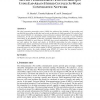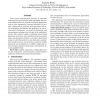50 search results - page 9 / 10 » A New Two-Party Identity-Based Authenticated Key Agreement |
112
Voted
CRYPTO
2006
Springer
15 years 4 months ago
2006
Springer
In a seminal paper, Feldman and Micali (STOC '88) show an n-party Byzantine agreement protocol tolerating t < n/3 malicious parties that runs in expected constant rounds. H...
131
Voted
STOC
2009
ACM
16 years 1 months ago
2009
ACM
We study the question of basing symmetric key cryptography on weak secrets. In this setting, Alice and Bob share an n-bit secret W, which might not be uniformly random, but the ad...
108
click to vote
CORR
2010
Springer
15 years 1 months ago
2010
Springer
The third generation partnership project (3GPP) has addressed the feasibility of interworking and specified the interworking architecture and security architecture for third gener...
122
click to vote
ACNS
2008
Springer
15 years 3 months ago
2008
Springer
Abstract. "Pairing" is referred to as the operation of achieving authenticated key agreement between two human-operated devices over a short- or medium-range wireless com...
126
click to vote
ACSAC
2001
IEEE
15 years 4 months ago
2001
IEEE
Secure group communication protocols, in particular multi-party key agreement and update algorithms, help promote traditional and new Internet multi-party applications such as vid...


